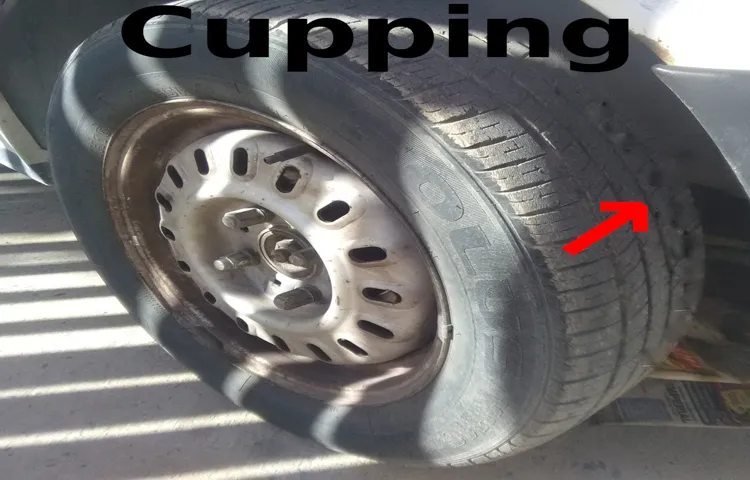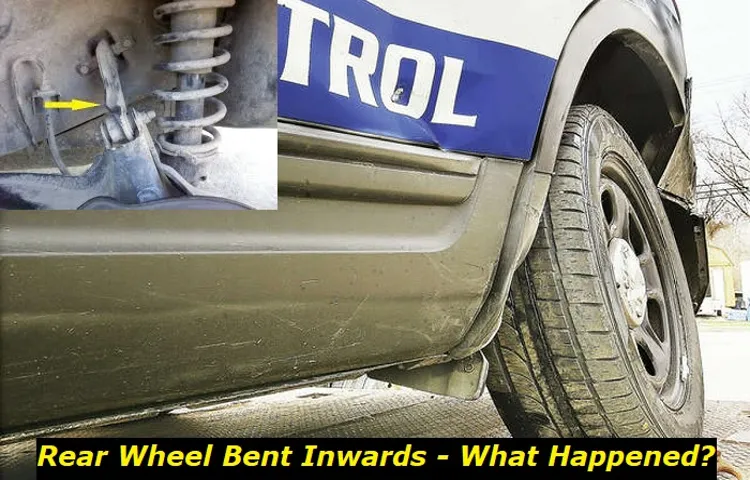Do you have a rear tire that appears to be leaning inward? This can be a cause for concern, as it can greatly affect the handling of your vehicle. A tire leaning inwards is often caused by a misaligned suspension system. When the suspension is not properly aligned, it can cause the tire to tilt, resulting in excessive wear on the inner edge of the tire.
This can cause the tire to wear unevenly and potentially lead to a blowout while driving. Another cause of a tire leaning inward could be worn or damaged suspension components. This can include worn out ball joints, control arms, or even springs.
When these components are worn or damaged, they can cause the tire to tilt, resulting in an unsafe driving condition. If you notice that your rear tire is leaning inward, it is important to have it inspected by a professional mechanic as soon as possible. Neglecting this issue could lead to costly repairs or a dangerous situation on the road.
So, don’t ignore it! Get it checked out and stay safe on the road.
Improper Wheel Alignment
Improper wheel alignment is a common cause of a rear tire leaning inward. When your vehicle’s wheels are not aligned, it can result in uneven wear and tear on your tires. This can cause the tire on one side to wear down more quickly, which in turn causes it to lean inward.
Improperly aligned wheels can also cause your vehicle to pull to one side or another while driving, making it difficult to maintain proper control. It’s important to have your wheels aligned regularly, especially if you notice any issues with your vehicle’s handling or tire wear. By doing so, you can ensure that your tires wear evenly and that your vehicle handles properly, making it safe and comfortable to drive.
Misaligned rear suspension
Improper wheel alignment can lead to a misaligned rear suspension, which can cause a variety of issues for your vehicle. When the wheels are not aligned properly, they will not be pointing in the same direction, leading to uneven tire wear and reduced handling performance. This can also cause your vehicle to pull to one side or the other while driving, making it less safe to operate.
Additionally, a misaligned rear suspension can cause your vehicle to ride rougher and make it more difficult to control, especially in challenging driving conditions. It can also lead to premature wear and tear on your vehicle’s suspension components, which can be costly to repair or replace.If you suspect that your vehicle’s rear suspension is misaligned, it’s important to have it inspected and repaired by a qualified mechanic.
They can use specialized equipment to measure and adjust your vehicle’s alignment, ensuring that it performs as it should. By taking care of your vehicle’s alignment and suspension, you can help ensure that it stays safe and reliable for years to come.

Worn-out suspension components
Improper wheel alignment can cause a host of problems that can impact your overall driving experience. One of the most significant issues is worn-out suspension components. When the wheels are not properly aligned, it can lead to uneven wear on the tires and create an excessive amount of stress on the suspension system.
This can cause your suspension components to wear out much more quickly than they would in a situation where the wheels are correctly aligned. As a result, you may experience a variety of problems, such as a rough ride, decreased handling, and even the risk of a tire blowout. To avoid these issues, it’s essential to have your wheels aligned by a professional mechanic every year or whenever you notice any signs of uneven tire wear.
By doing so, you can extend the life of your suspension components and enjoy a smoother, safer driving experience on the road.
Overloading the Vehicle
One of the factors that can cause a rear tire to lean inward is overloading the vehicle. When a vehicle is carrying too much weight, it puts excessive pressure on the wheels and can cause them to tilt inward, resulting in premature wear and tear. Overloading the vehicle can also lead to the suspension system being overstressed, which can further contribute to the tire leaning inward.
It is crucial to check the vehicle’s carrying capacity before loading it up and to ensure that the weight is evenly distributed. Remember, disregarding the weight limit can lead to not just damage to the rear tires but also endangerment to the driver and passengers. Therefore, always be mindful of the weight capacity of the vehicle and avoid overloading it, so your tires can remain upright and roadworthy.
Exceeding the weight limit
Overloading your vehicle can have serious consequences, and one of the most dangerous is exceeding the weight limit. This is a common driving offense that can occur when you pack too much stuff in your car or truck that it cannot safely handle. In fact, exceeding the weight limit can lead to an unsteady vehicle, loss of control, and even brake failure.
This is because carrying too much weight can put excessive pressure on the brakes, suspension, and tires. As such, it can affect areas of the vehicle that are critical to driver and passenger safety. To avoid such situations, it is important to be mindful of the capacity of your vehicle and not to go beyond it.
This can be especially important when hauling heavy equipment, towing a trailer or carrying large cargo. Remember that when you exceed the weight limit, you’re putting yourself, your passengers, and other road users at risk.
Incorrectly distributed cargo
Overloading the vehicle by incorrectly distributing cargo is a major issue that causes accidents on the road. It’s important to understand that the weight of the cargo, its size, and its shape can all affect how it needs to be distributed within the vehicle. If cargo is not properly secured or if it’s placed in an area that’s not designed for the weight, it can cause the vehicle to become unstable and cause an accident.
Overloading can also put unnecessary stress on tires, brakes, and suspension, leading to further issues down the line. To prevent overloading, make sure to check the weight limits and cargo guidelines for your vehicle and use a weight distribution system if necessary. Always place heavy items at the bottom and distribute weight evenly to ensure a safe and stable ride.
Remember, a little extra effort in properly distributing cargo can go a long way in preventing accidents and keeping everyone on the road safe.
Poor Tire Maintenance
Poor tire maintenance is a common cause of rear tires leaning inward. When tires are not properly inflated, it puts added stress on the inner sidewalls causing them to wear faster, and ultimately result in leaning inward. Overloading a vehicle also puts additional pressure on the rear tires causing them to lean inward.
This is why it is crucial to monitor the tire pressure as well as the weight that a vehicle carries. Other contributing factors to rear tire leaning inward may include worn suspension components, misaligned wheels, and damaged tires. It is essential to have regular maintenance checks on your tires to ensure that they are in good working condition.
By keeping up with maintenance, it can prolong the life of your tires and save you from costly repairs down the road.
Underinflated tires
Underinflated tires are a common issue that arises due to poor tire maintenance. This happens when the tires have less air pressure than what is recommended by the manufacturer. This can lead to a variety of problems, including reduced fuel efficiency, increased tire wear, and even tire failure.
Underinflated tires also negatively impact handling and braking performance, and can even cause the vehicle to swerve or drift while driving. It is important to regularly check the tire pressure and inflate them to the proper level to ensure maximum safety and performance on the road. Don’t let underinflated tires compromise the safety of you and your passengers.
Regularly checking your tire pressure is a simple and effective way to avoid potential problems on the road. Make sure you keep your tires properly inflated for a smooth and safe ride every time.
Unevenly worn tires
Maintaining your tires is vital for their longevity, your safety, and the performance of your vehicle. Poor tire maintenance can lead to uneven wear, a common problem that is avoidable. Unevenly worn tires can significantly impair your vehicle’s stability and control, especially on wet or slippery roads.
One of the most common causes of uneven tire wear is underinflation. When your tires are underinflated, it causes the sides of the tire to overstretch and wear faster than the center. Another common cause is overloading your vehicle beyond its capacity.
The excess weight puts added stress on your tires, leading to quicker and uneven wear. Routine tire rotations can also help prevent uneven wear. By rotating your tires, you can ensure that all four tires receive equal usage and wear.
Regular tire maintenance and inspections can help keep your tires in good shape, allowing for safer and more efficient driving.
Conclusion
While it may seem like a mystery to some, the explanation for why a rear tire leans inward is actually quite clear. It all comes down to the laws of physics and the way that weight distribution affects a bike’s balance. As the rider shifts their weight forward, the rear tire naturally leans inward to compensate and keep the bike stable.
So the next time you notice your rear tire tilting in, you can impress your friends with your knowledge of the science behind it. Just don’t forget to strike a cool pose as you explain it. “
FAQs
Why does the rear tire on my motorcycle lean inward?
There are several potential causes for a rear tire leaning inward, such as worn-out bushings, misaligned rear suspension, or a bent swingarm. It’s important to have a professional mechanic inspect your bike to properly diagnose and fix the issue.
Can riding with a misaligned rear suspension cause the rear tire to lean inward?
Yes, when the rear suspension is not aligned properly, it can cause one of the rear tires to tilt inward or outward, resulting in uneven wear and decreased performance.
How can I tell if my swingarm is bent and causing my rear tire to lean inward?
Look for signs of damage or warping on your swingarm, such as visible cracks or dents. Additionally, you may notice the tire rubbing against other parts of the motorcycle or uneven wear on the tire itself.
Can worn-out bushings cause my rear tire to lean inward, and how can I check for this?
Yes, worn-out bushings can cause misalignment and result in the rear tire leaning inward. To check for this, inspect the bushings for signs of wear, such as cracks or missing pieces. Additionally, you may notice excessive play or movement in the suspension when riding.
Are there any other potential causes for a rear tire leaning inward besides those mentioned?
Yes, other potential causes include a damaged or worn-out rear wheel bearing, a faulty shock absorber, or an improperly installed axle. It’s important to have your motorcycle inspected by a professional to properly diagnose and fix the issue.
Can riding on uneven roads contribute to a rear tire leaning inward?
Yes, frequently riding on uneven roads or rough terrain can cause damage to the rear suspension and result in misalignment. It’s important to take caution when riding over bumps or potholes and to have your motorcycle inspected regularly to prevent potential damage.
Will replacing the rear tire fix the issue of it leaning inward?
No, in most cases, replacing the rear tire will not fix the issue of it leaning inward. It’s important to properly diagnose and fix the underlying issue causing the misalignment before replacing the tire to prevent further damage.

